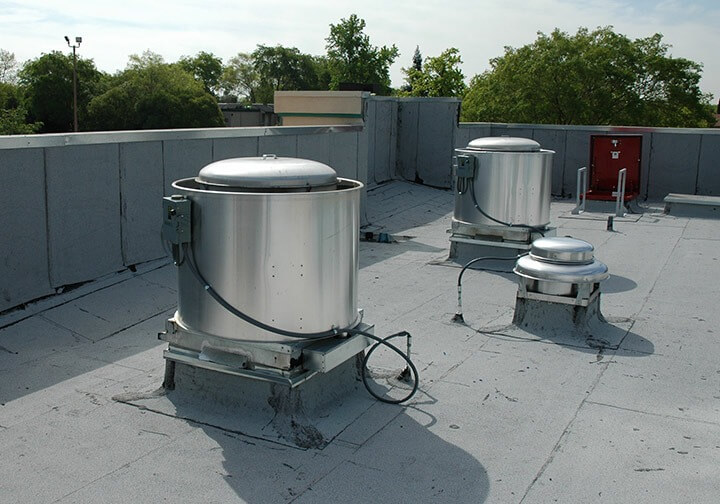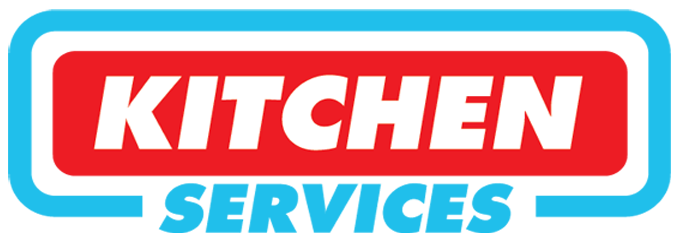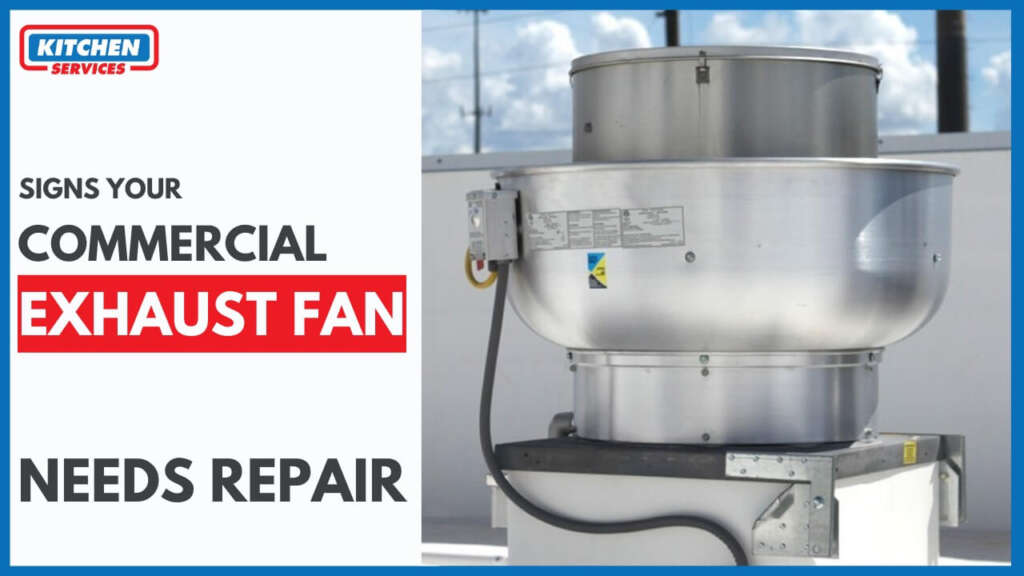As we are all aware of the fact that restaurants have food cooking process going on a daily basis, so the most basic and important element inside any restaurant’s kitchen would be the exhaust fan in it. Since, it is an exhaust fan that helps in removing smoke and moisture from the air, in order to keep your kitchen’s air clean. The most prominent and basic problem that might occur if your exhaust fan all of a sudden crashes which can also result in your business closures. This article will list down signs that show your Commercial Exhaust Fan Needs Repair.
Being a restaurant owner, a faulty or crashed hood can create a lot of health hazards due to potential monoxide poisoning as we know that one of the crucial functions of the exhaust hood is to eliminate carbon monoxide from gas-operated cooking appliances.
Without your commercial kitchen exhaust fans, a lot of major problems can arise, and the results would be terrible and unbearable, after all, you never want to shut down your commercial kitchen completely at any cost. Apart from their basic importance, some systems are not properly installed, and thus they can pose a danger to building residents. Not only can they cause fire hazards, but they may fail to effectively remove airborne grease. The amount of investing in a competent commercial HVAC technician is a lot less than the expense of repairing a damaged building, or worse yet, having to replace it together.
Contact for Commercial Hood Repair
Commercial Exhaust Fan Troubleshooting
Commercial exhaust fans are critical for proper ventilation in kitchens, manufacturing facilities, warehouses, and other commercial environments. When these fans malfunction, it can lead to poor air quality, increased humidity, and potential equipment damage. Here’s a step-by-step guide to troubleshooting common issues with commercial exhaust fans:
1. Fan Doesn’t Turn On
- Check Power Supply: Ensure the fan is connected to a power source and check the circuit breaker. Sometimes, a tripped breaker or blown fuse can cause power loss.
- Test the Switch: Inspect the wall switch or control panel to ensure it’s functioning properly.
- Inspect Wiring: Loose or damaged wiring could prevent the fan from operating. Check connections and repair or replace damaged wires.
- Motor Issues: If the power and wiring are intact, the motor could be faulty. A burnt motor may need replacement.
2. Fan Runs Slowly
- Dirty Blades or Motor: Build-up of grease, dirt, or debris on fan blades or inside the motor can reduce performance. Clean both thoroughly.
- Worn Bearings: Over time, fan bearings can wear out, causing the fan to run slowly. Lubricate or replace the bearings as needed.
- Voltage Drop: Low voltage can affect fan speed. Check the power supply and ensure the correct voltage is reaching the fan.
3. Excessive Noise
- Loose Parts: Inspect for any loose screws, bolts, or mounting brackets. Tighten all fasteners to eliminate rattling.
- Worn Bearings or Belts: Squealing or grinding sounds often indicate worn bearings or a damaged belt. Replace as needed.
- Fan Blades: Misaligned or unbalanced fan blades can cause noise. Ensure blades are straight and not bent.
4. Fan Vibrates Excessively
- Imbalance in Blades: Dust or debris on blades can create imbalance, leading to vibration. Clean and rebalance the blades.
- Motor Mounting: Loose or damaged motor mounts can cause the fan to vibrate. Tighten or replace mounts.
- Worn Bearings or Shafts: Worn or misaligned bearings or shafts can also cause excessive vibration and may need to be replaced.
5. Poor Airflow
- Blocked Ventilation: Ensure the exhaust ducts and vents are not blocked by dirt, grease, or debris. Clean the ductwork as needed.
- Clogged Filters: Some systems have filters that need regular cleaning or replacement to ensure proper airflow.
- Fan Size: If the fan is too small for the space or ductwork, it won’t produce sufficient airflow. Consider upgrading to a larger unit.
6. Overheating
- Dirty Motor: A motor clogged with dirt and grease will overheat. Clean the motor and ensure it’s properly ventilated.
- Improper Voltage: Check that the motor is receiving the correct voltage. An incorrect voltage can cause the motor to overheat.
- Motor Overload: Running the fan at high speeds for prolonged periods can overheat the motor. If this is the case, reduce usage or switch to a more robust fan.
7. Fan Shuts Off Randomly
- Thermal Overload Protection: Many fans have built-in thermal protection that shuts the fan off if the motor overheats. Allow the fan to cool down and check for overheating causes (dirty motor, low voltage).
- Faulty Motor: If the motor repeatedly shuts off, it may be defective and need replacement.
8. Exhaust Fan Leaks Water or Grease
- Ductwork Issues: Water or grease leaks may indicate condensation or grease buildup in the ductwork. Clean and check for proper drainage.
- Seal Problems: Ensure that the fan housing and duct connections are properly sealed to prevent leaks.
Proper maintenance and timely troubleshooting can help extend the life of your commercial exhaust fan and prevent costly repairs. If issues persist after troubleshooting, it may be necessary to consult a professional HVAC technician.
For any of these problems, it’s essential to get professional help to ensure the system runs safely and efficiently. We, at Kitchen Services, provide our customers with professional kitchen exhaust fan repair and maintenance services.
Also Read: Types of Exhaust Fans
Exhaust Fan Maintenance Checklist

- Power Off: Always turn off power before performing maintenance.
Monthly Tasks:
- Inspect Fan Blades:
- Check for dirt, grease, and debris buildup on blades.
- Clean fan blades with a degreaser if necessary.
- Inspect Housing:
- Look for dirt or grease on the fan housing and clean as needed.
- Check Electrical Connections:
- Ensure all wiring and electrical connections are secure.
- Inspect Belts (If Belt-Driven):
- Check for wear, tension, or fraying.
- Replace or adjust belts as necessary.
Quarterly Tasks:
- Lubricate Bearings:
- Apply lubricant to motor bearings, pulleys, and other moving parts (if applicable).
- Clean Ductwork and Vents:
- Remove grease, dust, and debris from ducts and vent openings.
- Check Motor:
- Inspect the motor for overheating, unusual noise, or wear.
- Inspect Mounting Hardware:
- Tighten any loose screws, bolts, or brackets.
Semi-Annual Tasks:
- Inspect Filters:
- Clean or replace filters to ensure proper airflow (if applicable).
- Check Airflow:
- Ensure the fan is providing proper ventilation by measuring airflow output.
- Test System Performance:
- Turn on the fan and monitor its operation for noise, vibration, and proper function.
Annual Tasks:
- Full Inspection:
- Perform a comprehensive inspection of the fan, including blades, motor, ductwork, and electrical components.
- Check for Leaks:
- Inspect for any water or grease leaks in and around the exhaust fan and ductwork.
- Check Fan Balance:
- Ensure fan blades are balanced and not bent, as this could cause vibration or noise.
We offer complete solutions for kitchen hood repair for commercial kitchens and restaurants in Los Angeles.

